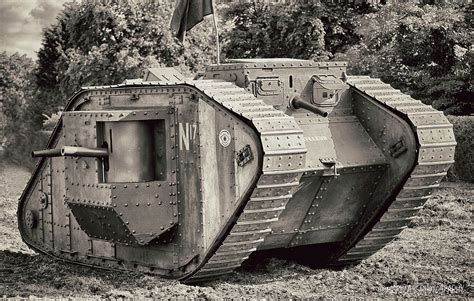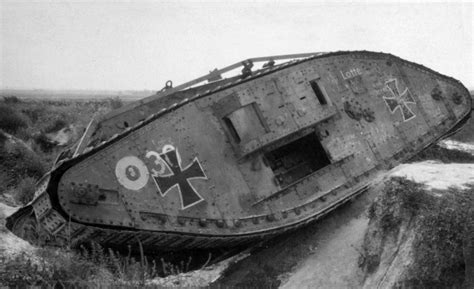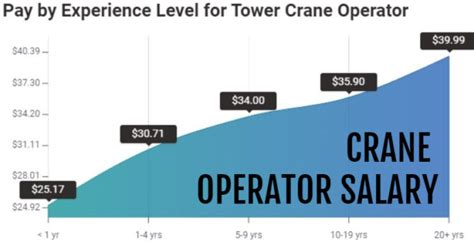The advent of tanks during World War I marked a significant shift in modern warfare, with various nations developing their own versions of these armored vehicles. Among the belligerents, Germany's foray into tank development was notably belated and ultimately less successful than that of the Allies, particularly the British and French. The primary reason behind Germany's delayed entry into tank production was its initial skepticism regarding the effectiveness of tanks in combat, a skepticism that was gradually overcome as the war progressed and the potential of armored warfare became more apparent.
Germany's first tank, the A7V, was a cumbersome and relatively ineffective machine, weighing around 30 tons and armed with a 57mm gun, along with several machine guns. The design and production of the A7V were the result of a collaboration between the German War Ministry and several private companies, with the first prototype appearing in 1917. Despite its limited mobility and range, the A7V represented a crucial step in Germany's development of armored warfare capabilities, albeit one that was hindered by production difficulties and a lack of resources.
Key Points
- The A7V was Germany's first tank, developed in response to the Allies' successful deployment of tanks.
- Production of the A7V was limited due to resource constraints and technical challenges.
- The A7V saw limited action during World War I, primarily during the Battle of St. Quentin in March 1918.
- Germany also developed the LK I and LK II, lighter tank designs intended for mass production, but these projects were ultimately canceled due to the war's end.
- The experience gained from the A7V and other early tank designs laid the groundwork for Germany's more successful tank developments in the interwar period.
Development and Production Challenges

The development and production of German tanks during World War I were fraught with challenges. The A7V, for instance, was designed to counter the British Mark IV tank but faced significant production delays due to a lack of resources, particularly steel, and the complexity of its design. The engine power was insufficient for the tank’s weight, resulting in poor mobility, and its armament, while formidable on paper, was not as effective in combat as had been anticipated. These issues, coupled with the Allies’ superior numbers of tanks, meant that Germany’s tank force was always at a disadvantage.
Operational History of the A7V
The A7V saw its first and most notable action during the Battle of St. Quentin in March 1918, as part of the German Spring Offensive. Although the A7V tanks managed to break through the enemy lines in some areas, their impact was limited due to their small numbers and mechanical reliability issues. The tanks were also prone to getting stuck in the muddy terrain, which further reduced their effectiveness. Despite these limitations, the deployment of the A7V marked an important milestone in the development of German armored forces, offering valuable lessons for future tank design and deployment.
| Characteristics | A7V |
|---|---|
| Crew | 18 |
| Weight | Approximately 30 tons |
| Armament | 1 x 57mm gun, several machine guns |
| Top Speed | About 4 mph (6.4 km/h) |
| Range | Approximately 12 miles (19 km) |

Legacy of World War I German Tanks

The legacy of Germany’s World War I tank program is one of both failure and foundation. While the A7V and other German tanks of the period were not as successful as their Allied counterparts, they represented an essential step in the development of German armored capabilities. The lessons learned from these early tank designs, including the importance of mobility, reliability, and coordinated deployment, were crucial in shaping Germany’s approach to armored warfare in the decades that followed. This experience would eventually contribute to the creation of highly effective and feared tank forces during World War II, highlighting the significance of the foundational, albeit limited, successes of Germany’s World War I tank program.
What was the primary reason for Germany’s delay in developing tanks during World War I?
+The primary reason was Germany’s initial skepticism regarding the effectiveness of tanks in combat, which gradually gave way to a recognition of their potential as the war progressed and the Allies began to deploy tanks successfully.
How many A7V tanks were produced during World War I?
+Only about 20 A7V tanks were produced during World War I, a number that was insufficient to make a significant impact on the battlefield.
What were the main limitations of the A7V tank?
+The A7V tank had several limitations, including poor mobility due to insufficient engine power, mechanical reliability issues, and a propensity to get stuck in muddy terrain. Additionally, its armament, while substantial, was not as effective in combat as anticipated.


